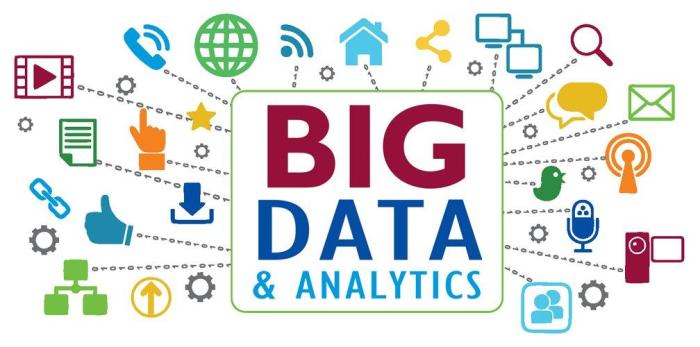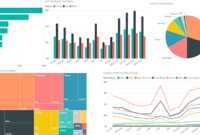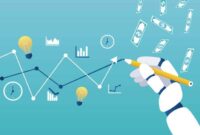Big data analytics takes center stage, beckoning readers into a world where data-driven decisions shape the future. Dive into the realm of extracting valuable insights from complex data sets with this comprehensive guide.
Explore key technologies, challenges, and applications that define the landscape of big data analytics.
Introduction to Big Data Analytics
Big data analytics is the process of examining large and varied data sets to uncover hidden patterns, unknown correlations, market trends, customer preferences, and other useful information that can help organizations make informed decisions. In today’s data-driven world, the importance of big data analytics cannot be overstated.
Efficiently transferring data from one system to another is crucial for businesses, and data migration tools play a key role in this process. These tools simplify the migration process, ensuring data integrity and minimizing downtime during the transition.
By utilizing big data analytics, organizations can gain valuable insights from massive amounts of data that would otherwise be too complex to analyze using traditional methods. This enables them to optimize operations, improve decision-making processes, identify new revenue opportunities, and ultimately gain a competitive edge in the market.
When it comes to making strategic decisions, businesses rely on decision support systems to analyze data and provide valuable insights. These systems help in evaluating various scenarios and outcomes, ensuring that the best choices are made for the organization’s success.
Role of Big Data Analytics
Big data analytics plays a crucial role in extracting valuable insights from large and complex data sets. Here are some key aspects of how big data analytics helps organizations:
- Identifying trends and patterns: Big data analytics can help organizations identify trends and patterns in data that may not be apparent through traditional analysis methods. By recognizing these patterns, organizations can make data-driven decisions that lead to improved outcomes.
- Enhancing decision-making: With the help of big data analytics, organizations can make more informed decisions based on data-driven insights rather than relying on intuition or gut feelings. This can lead to better outcomes and more successful strategies.
- Improving operational efficiency: Big data analytics can optimize business processes and workflows by identifying areas for improvement and streamlining operations. This can result in cost savings, increased productivity, and overall operational efficiency.
- Personalizing customer experiences: By analyzing large amounts of customer data, organizations can gain a better understanding of their customers’ preferences, behaviors, and needs. This enables them to personalize their products and services to meet customer demands more effectively.
Big Data Technologies

Big data technologies play a crucial role in processing and analyzing massive datasets efficiently. Key technologies such as Hadoop, Spark, and NoSQL databases are widely utilized in big data analytics to handle the volume, velocity, and variety of data.
Hadoop
Hadoop is an open-source framework that allows for the distributed processing of large data sets across clusters of computers using simple programming models. It consists of two main components: Hadoop Distributed File System (HDFS) for storage and MapReduce for processing. Hadoop enables scalability, fault tolerance, and cost-effective storage and processing of big data.
Spark
Spark is a fast and general-purpose cluster computing system that provides in-memory data processing capabilities. It offers a more flexible and efficient alternative to MapReduce for processing large-scale data. Spark’s ability to perform real-time data processing, iterative algorithms, and interactive queries makes it a popular choice for big data analytics.
NoSQL Databases
NoSQL databases, such as MongoDB, Cassandra, and Redis, are designed to handle unstructured and semi-structured data efficiently. These databases provide horizontal scalability, high availability, and flexibility to store and retrieve data in a non-relational format. NoSQL databases are well-suited for big data applications that require fast and flexible data access.
Cloud Computing
Cloud computing plays a significant role in supporting big data analytics infrastructure by providing on-demand access to computing resources and storage. Cloud platforms like Amazon Web Services (AWS), Google Cloud Platform, and Microsoft Azure offer scalable and cost-effective solutions for storing, processing, and analyzing large volumes of data. The flexibility and agility of cloud computing enable organizations to scale their big data operations based on demand and reduce infrastructure costs.
Data Collection and Storage

Data collection and storage play a crucial role in big data analytics, as they involve gathering and organizing large volumes of data for analysis. This process is essential for deriving valuable insights and making informed decisions based on data-driven trends and patterns.
When it comes to storing and managing big data, there are several challenges that organizations may face. One of the main challenges is the sheer volume of data being generated, which can quickly overwhelm traditional storage systems. Additionally, big data comes in various formats, including structured, semi-structured, and unstructured data, making it difficult to store and manage effectively.
To address these challenges, different storage solutions have been developed for big data. Two common solutions are data lakes and data warehouses. Data lakes are storage repositories that can hold vast amounts of raw data in its native format until it is needed for analysis. On the other hand, data warehouses are designed to store structured data from various sources in a way that is optimized for querying and analysis.
Data Lakes
Data lakes are ideal for storing large quantities of raw data, including structured, semi-structured, and unstructured data. They provide a centralized repository where organizations can store all their data without the need to structure it beforehand. This flexibility allows for faster data ingestion and analysis, making it easier to derive insights from diverse data sources.
- Data lakes can scale horizontally, meaning they can easily accommodate growing amounts of data without affecting performance.
- They support a wide range of data formats, making it easier to integrate data from different sources.
- Data lakes enable organizations to perform advanced analytics, such as machine learning and artificial intelligence, on raw data without the need for preprocessing.
Data Warehouses
Data warehouses, on the other hand, are designed to store structured data in a way that is optimized for querying and analysis. They are typically used for storing historical data that has been cleaned, transformed, and organized for specific use cases, such as business intelligence and reporting.
- Data warehouses provide a structured, organized view of data, making it easier for analysts and decision-makers to access and analyze information quickly.
- They are optimized for complex queries and reporting, allowing for faster access to insights and trends within the data.
- Data warehouses often integrate with business intelligence tools, enabling users to create reports, dashboards, and visualizations based on the stored data.
Data Processing and Analysis: Big Data Analytics
Data processing and analysis are crucial steps in deriving meaningful insights from big data.
Role of Machine Learning and AI Algorithms
Machine learning and AI algorithms play a significant role in analyzing large data sets by automating the process of identifying patterns, trends, and anomalies. These algorithms can handle vast amounts of data and learn from it to make predictions and decisions without explicit programming instructions.
- Machine learning algorithms like regression, classification, clustering, and neural networks can be applied to big data to uncover hidden patterns and relationships.
- AI algorithms, such as natural language processing and deep learning, can process unstructured data like text, images, and videos to extract valuable insights.
- The use of machine learning and AI in big data analytics enables organizations to make data-driven decisions, enhance customer experiences, and optimize business operations.
Importance of Data Visualization
Data visualization plays a crucial role in interpreting and communicating analytical results effectively. It helps in presenting complex data in a visual format that is easy to understand and interpret.
- Data visualization tools like charts, graphs, and dashboards enable analysts to identify trends, outliers, and patterns in data quickly.
- Visual representations of data make it easier for stakeholders to grasp the insights derived from big data analysis and make informed decisions based on the findings.
- Interactive data visualizations allow users to explore data dynamically, drill down into specific details, and gain a deeper understanding of the underlying data.
Applications of Big Data Analytics

Big data analytics is widely used across various industries to extract valuable insights from large volumes of data. By leveraging advanced analytics techniques, organizations can make data-driven decisions to improve operations, enhance customer experiences, and drive business growth.
Healthcare Industry
In the healthcare sector, big data analytics plays a crucial role in improving patient outcomes, reducing costs, and enhancing operational efficiency. By analyzing patient data, medical records, and treatment outcomes, healthcare providers can identify trends, predict potential health issues, and personalize treatment plans. For example, predictive analytics can help in early disease detection, prevent hospital readmissions, and optimize resource allocation.
Finance Sector
Financial institutions leverage big data analytics to detect fraudulent activities, assess credit risks, and enhance customer satisfaction. By analyzing transactional data, market trends, and customer behavior, banks and insurance companies can identify potential risks, predict market fluctuations, and tailor financial products to meet customer needs. For instance, predictive analytics can help in identifying suspicious transactions, predicting customer churn, and optimizing investment strategies.
Marketing and Retail
In the marketing and retail industry, big data analytics is used to understand consumer preferences, optimize marketing campaigns, and improve sales performance. By analyzing customer data, purchase history, and market trends, businesses can create targeted marketing strategies, personalize customer interactions, and forecast demand. For example, sentiment analysis can help in understanding customer feedback, predicting buying patterns, and optimizing pricing strategies.
Predictive Analytics and Forecasting
Big data analytics enables organizations to use historical data to predict future outcomes and trends. By applying statistical algorithms and machine learning models to large datasets, businesses can forecast demand, anticipate customer behavior, and optimize inventory management. For instance, retailers can use predictive analytics to forecast sales, manufacturers can predict equipment failures, and healthcare providers can anticipate patient outcomes.
Improving Customer Experiences and Business Operations, Big data analytics
By leveraging big data analytics, organizations can enhance customer experiences by personalizing interactions, improving service quality, and addressing customer needs proactively. Additionally, businesses can streamline operations, optimize processes, and make data-driven decisions to drive efficiency and productivity. For example, e-commerce companies can recommend personalized products to customers, airlines can optimize flight schedules based on demand forecasts, and manufacturing firms can reduce downtime by predicting equipment maintenance needs.
In a nutshell, big data analytics revolutionizes industries, empowers decision-making, and enhances customer experiences. Stay ahead of the curve with the power of data insights at your fingertips.
Businesses are constantly looking for ways to stay ahead of the competition, and predictive analytics enable them to forecast trends and make informed decisions. By analyzing historical data and identifying patterns, businesses can predict future outcomes and take proactive measures to achieve their goals.




